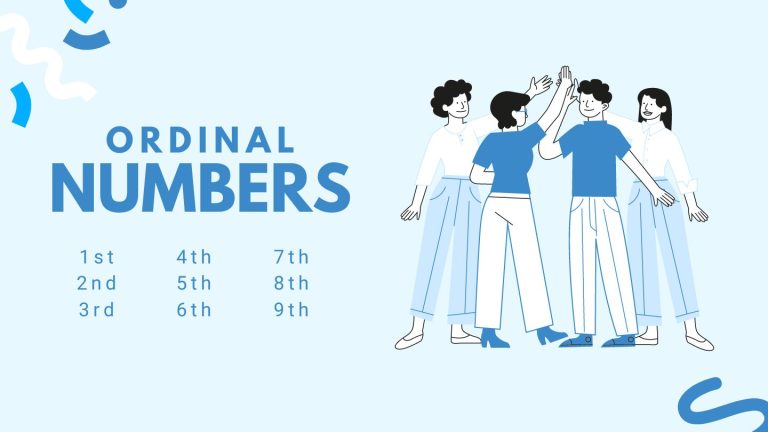Ordinal Numbers

Ordinal numbers tell us the order of things, like first, second, and third. Imagine you’re in a race. If you cross the finish line first, you’re in 1st place. That’s an ordinal number.
They help us understand our position in a line or a list. So, if you’re third in line for ice cream, you know two people are ahead of you because of ordinal numbers.
Ordinal Numbers
We use ordinals to rank things, showing what comes where in a sequence. For instance, when we talk about the first day of school, we mean the very beginning of the school year.
Here’s a diagram that shows you ordinal numbers starting with first to one-hundredth. Ordinal numbers can continue all the way to infinite. But for simplicity, this chart is only to one hundred.
Now that you have an idea of what ordinal numbers are, how do we use them? Let’s take a closer look at the use cases for ordinal numbers.

1. Calendar and Dates
For calendars and dates, ordinals help us know the day’s position in a month. So, if it’s your birthday on the 5th of April, the “5th” tells us it’s the fifth day in April.
We say “the first of January” for New Year’s Day, showing it’s the start of the year. These numbers make it clear when events happen, like “the 31st of October” for Halloween.
2. Rankings and Positions
We use ordinal numbers to show rankings and positions, like in competitions or lists. For example, if you’re third in a race, it means two people finished ahead of you.
In a class rank, being first means you have the top grades. And if a movie is rated as the second-best of the year, it’s just behind the first in quality.
Comparatives and ordinals both involve comparison and ranking. But comparatives compare two things (e.g., taller, faster), while ordinals indicate position in a sequence (e.g., first, second).
3. Sequences and Series in Math
In math, ordinals help us with sequences and series, showing the order of items. For instance, when we say the “third term” in a sequence, we mean the item that comes third in the list.
A 1st order equation involves the first power of the variable, like x in ax + b = 0. It’s simple and straight to the point. A 2nd order equation goes a step further, involving the square of the variable, like x2 in ax2 + bx.
4. Royal Titles
For royal titles, ordinals show which king or queen we’re talking about when there have been several with the same name. King Henry VIII means he was the eighth King Henry of England.
Queen Elizabeth I was the first Queen Elizabeth. And St. Louis IX means he was the ninth Louis to be king of France. These numbers help us keep track of history, telling us their place in the line of rulers.
5. Book Editions
For book editions, ordinal numbers tell us the version of the book. If a book is called “2nd Edition,” it means it’s the second version that’s been released.
This could also include updates, corrections, or added content. A “5th Edition” has been revised four times after its original publication. So, ordinals in book editions help readers know they’re getting the latest information.
6. Steps or phases
Ordinal numbers denote the order of steps or phases, like “first step”, “second phase”, or “final stage”.
These numbers guide us through the order we need to follow to reach our goal. They ensure we don’t miss important stages, like preheating the oven before baking.
7. School grades
In school grades, ordinals tell us the level of education a student is at. For example, “1st grade” is the first year of elementary school, where learning begins with basics like reading and math.
By the time a student reaches “8th grade,” they’ve progressed through eight years of schooling, gaining more knowledge each year. So, ordinal numbers in school grades show the sequence of learning.
8. Anniversaries
Are you forgetting your anniversary? Ordinal numbers celebrate milestones or anniversaries, like “10th anniversary” or “25th wedding anniversary”.
Celebrating a “50th anniversary” marks a major milestone of half a century together. When a company celebrates its “100th anniversary,” it’s celebrating a century of business.
Ordinal Numbers
Ordinal numbers help us keep track of order and celebrate special moments. They show us the sequence of things, like grades in school or anniversaries.
They also help us understand where we are in a process, like steps in a recipe or editions of a book. Simply put, ordinal numbers make our lives more organized and help us see our progress and important milestones.
